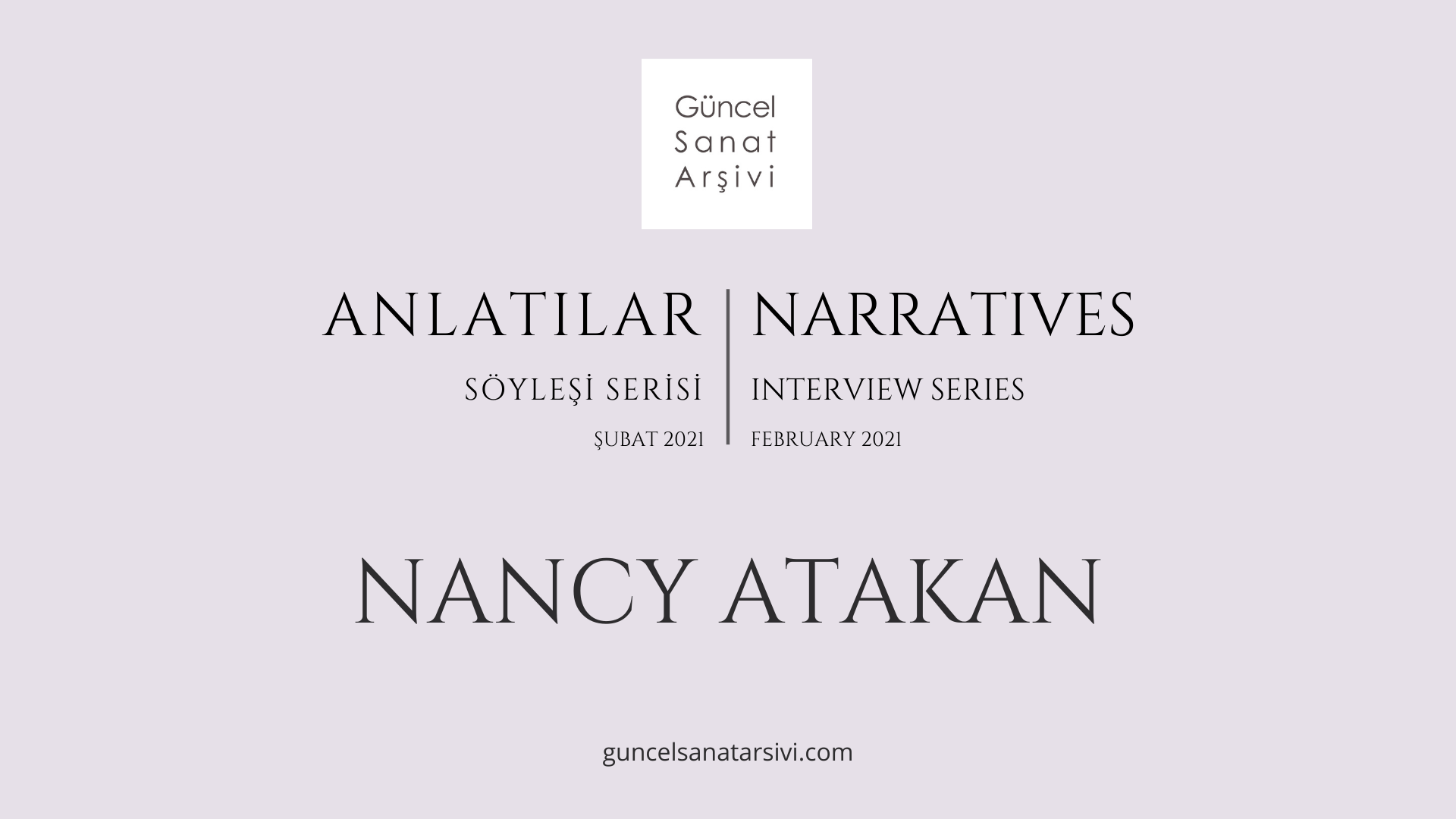Interview: Seniha Ünay / About
Translation: Burçin Nilay Kalınbayrak / About
The guest of the sixth issue of the Narratives Interview Series in February is Nancy Atakan who addresses the issues of women, identity, belonging, and memory through the stories of women. While Atakan shares the results of her research over the years, she maintains the tradition of beautiful needlework, lace, and embroidery which we all may be inherited from our grandmothers, have been keeping at our homes to use one day, have watched while our grandmothers were embroidering, but perhaps have never looked closely. She brings the memories and experiences of women to the present while keeping the traditional embroidery practices alive in her works. During the interview, we had the opportunity to talk with Atakan about the importance of traditional embroidery techniques in her production process, the reflection of women’s memories on her works, the impact of her versatile personality on her art, and her research and cooperation processes in her works.
“Both the needlework that I inherited from my husband’s grandmother and the work by the women I interviewed should be in museums rather than trunks.”

After your education in Fine Arts and History of Art in the United States, you received your Master’s degree in Educational Sciences at Boğaziçi University and your Ph.D. in History of Art at Mimar Sinan Fine Arts University. You have been living in Istanbul since 1969, and thinking and producing on the theory and practice of art. You are a versatile person who is not only an artist but also a writer, lecturer, art historian, and art critic. Could you tell us how these different fields in your educational background and your versatility shape your life and art?
Everything I see, experience, live, think, read, and write intertwines. For me working in the art arena is a way to understand (as much as I am capable of understanding) the past, present, and future. Sometimes I spend years doing research. For me, even though I do eventually share my findings in the form of an artwork with the public, the process and idea greatly outweigh a finished project in value. I am fascinated by words, translation, understanding, misunderstanding, and their relationship to images.
Nothing in my life was really planned. Things just happened organically. One question led to another. One journey opened up the possibility of another. Curiosity, love, trying to do whatever I am doing as best I can, and sometimes anger at injustice, led me forward. My art practice emphasizes collaboration and sharing and listening to others.
“And”, a text based work, from the 1990s still presents my idea that relationships, that which happens in the gap in-between two people, is what is important. I first presented “And” as an additive sculpture. I translated it into Turkish and had one of my students correct my Turkish digital print on the gallery wall in red ink. In 2007 “And” became an animated film in which I moved between places making myself into a conjunction. I connected imaginary images placing myself neither inside nor outside the space, neither there nor not there as I attempted to connect spaces, sounds, writing, and images.
For me teaching, writing, reading, living, making art, relationships, dialogue… are simply organically connected and intertwined.

And
and is neither this nor that
and is always in-between two things and belongs to neither
and marks the border of each
and has neither beginning nor end within and experiences develop events take place
revolutions evolve
like a river and flows
barely perceivable
and picks up speed in the middle and undermines its own banks

Nancy Atakan, “And”, Digital Video, 2’06”, 2007.
You are working on issues such as identity, memory, gender, culture, and history. In all of your works, there is a feeling that tells and reminds us of ourselves. What are the factors that lead you to work on these issues? Could you talk about your thought and production processes that reveal the issues in your works?
It seems to me that artists have just a few topics that they explore their whole lives. Probably, individuality determines what these will be. My childhood and the games I played, the lack of any type of art in my life before leaving my childhood home, my fascination with photographs must have played a role. Perhaps, it is because I am a woman, or perhaps because I am in a sense a displaced person and therefore interested in place, that I turn these topics upside down and approach them from different perspectives, but the basic question or issue or idea or topic remains the same. I read continuously and have found important ideas on the subject of women in works by Judith Butler, Luce Irigaray, Susan Sontag, and Julia Kristeva. Last year I added Ursula K. Le Guin and Donna Haraway. I ask younger friends, for example, Nora Tartaryan, Naz Cuguoğlu, Merve Ünsal, Meltem Sarıçiçek for book recommendations. Another of my particular interests is giving voice to women who have been left out of history. Research often leads to visual storytelling someplace between fact and fiction. Gentrification has continually appeared as a topic of interest and now I am particularly interested in ecology. These topics involve a different list of authors and books.
To my surprise, some of my most personal work seems to speak to others. My 2000 digital print, “I am Born Every Minute”, is presently being used as a poster image for a series of talks, “Bread and Thorns: Women’s issues in Contemporary Turkey”, at the Fashion Institute of Technology (FIT) in New York City; my 2002 work, “Couldn’t Be It”, resonates with many women who have never been able to please their mothers; and my 2001, “Silent Scream”, has been exhibited over and over because everyone has feelings of helplessness, frustration, anger, and powerlessness. Throughout the years, particularly in my videos, I have returned to these topics from varying perspectives.
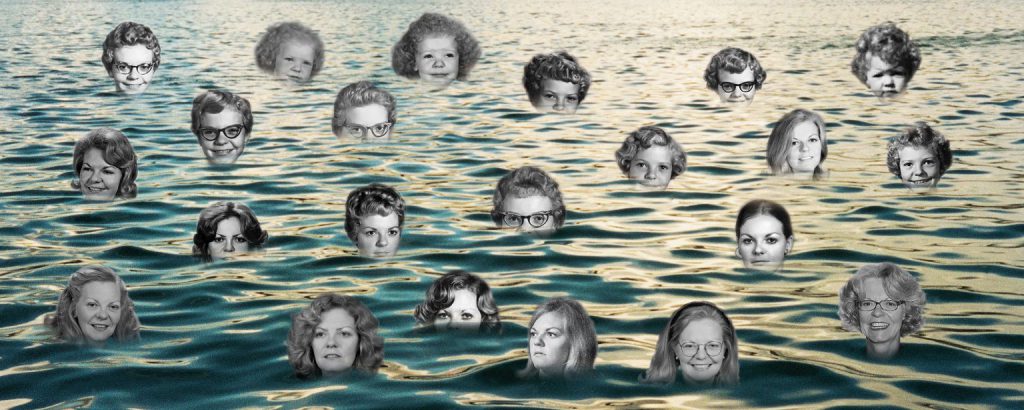
Nancy Atakan, “I am Born Every Minute”, Digital Print, 1×2.5 m, 2000 / 40×120 cm, 2009.

Nancy Atakan, “Couldn’t Be It”, Digital Print, 50×70 cm, 2001/2009.

Nancy Atakan, “Silent Scream”, Digital Print on Plexiglas, 52×92 cm, 2001 / 34×60 cm, 2009.
“Throughout history painting has been a male dominated technique and I didn’t want to be a part of that tradition.”
We see that you stopped painting after a while. You make your works with methods such as sewing and embroidery, which are mostly attributed to women or remembered with women. As a woman, could you mention why you address the women related issues through the methods that are usually associated with women?
After I finished my Ph.D. at Mimar Sinan Fine Arts University, I stopped painting for two reasons. First, I realized I had never wanted to paint, but made paintings because I thought that was what an artist must do. Second, throughout history painting has been a male dominated technique and I didn’t want to be a part of that tradition. At essence I guess, I just prefer to work with other media.
In my work, a new philosophy of art and mode of materialization of ideas emerged in the mid-1990s, but I kept elements from my early paintings, such as photocopies of family snapshots, cloth, and topics about globalization, place, and female identity. My first research project that resulted in an artist book and an installation called, “Those Who Say ‘Tea’ and Those Who Say ‘Çay’”, referenced Walter Benjamin and used photographs and colored photocopies. In my first analog film (1994 reproduced in 2012) “Documentation”, I recited a tautology of my definition of an art object as a documentation. As technology changed I moved from photocopy and analogue film to digital printing and digital video, but my philosophy remained basically constant.
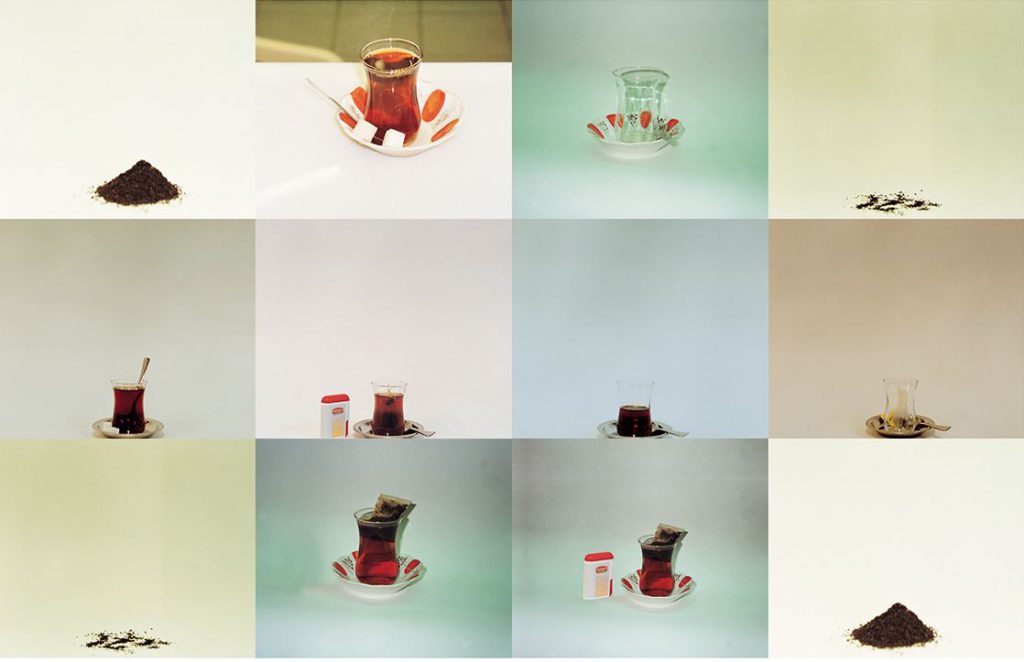
Nancy Atakan, “Those Who Say ‘Tea’ and Those Who Say ‘Çay’”, 48 Colored Photocopies, 30×35 cm, 48 Colored Photographs, 30×35 cm, 1998.

Nancy Atakan, “Documentation”, Looping Single Channel Video, 1’, 1994/2012.
I carried my interest in lace and needlework from my paintings into my new art practice. In the 1980s my watercolor paintings, my designs, included elements from embroidery. After years of research, in 2004 I made the film, “Grandmother’s Lace”, centered around elderly women from my husband’s family showing antique needlework and lace stored in their trunks. Both the needlework that I inherited from my husband’s grandmother and the work by the women I interviewed should be in museums rather than trunks. I questioned why these beautifully designed works by women were seen as handicrafts and oil paintings made by men as fine arts objects. Why is the work by male painters revered and exalted in grandiose museums while the equally magnificent creative work made by women stored out of sight in trunks?
Nancy Atakan, “Grandmother’s Lace”, Digital Film Installation, Trunk, Lace, 12’, 2004.
“I realized that in a period in history when women around the world were not allowed to publish novels or receive equal acclaim as painters, they could make embroidery that included their own ideas, words, poems, and research.”
My research took me from an interest in Turkish lace and embroidery to antique Western samplers (initially these small stitched pieces of cloth were made by daughters learning needlework skills from their mothers) stored in the Metropolitan Museum in NYC and the Victory and Albert Museum in London. I realized that in a period in history when women around the world were not allowed to publish novels or receive equal acclaim as painters, they could make embroidery that included their own ideas, words, poems, and research. In the Metropolitan Museum when I found samplers by a woman who had documented in needlework with architectural precision all the buildings in her small town including information about their history, architects, and inhabitants, I decided to use a similar format for my topics of inquiry.
As needlework became a more important part of my practice, I moved from commissioning professionals to embroider my drawings to doing the embroidery myself. In my 2017 solo exhibition, “Community of Lines”, at Pi Artworks Istanbul, I both drew and embroidered my first piece, “Our Grandmothers in New Turkey”, from a story the curator, Asli Seven, had shared with me about her grandmother who taught needlework in women’s institutions in the early 20th century.

Nancy Atakan and Aslı Seven Collaboration, “Our Grandmothers in New Turkey”, Brown, Beige and Orange felt, Needlework on Linen, 50 cm x 3 m, 2017.
Perhaps as a symbol for female oppression, as an explanation for my movement to needlework, and perhaps as a premonition of the pandemic, I made the 2016 video, “Ascribed”, that is now being shown in Noyes Museum in New Jersey, USA. In this video, two women of like age sit in a deep dark hole unable to formulate words. Their frustration leads to a prolonged scream after which they surrender and stitch a sign, EMERGENCY, the situation of today’s world.

Nancy Atakan, “Ascribed”, 2 Channel Digital Video, 3’26”, 2016.
Historical narratives, photographs, archive documents seem to be the leading components of your works. For example, in your work “My name is in Azade (Freedom)”, you tell the story of Azade Kent, Turkey’s first gymnastics teacher. Can we say that you are chasing and writing stories? Also, through this work, could you touch on the research, cooperation, and dialogue processes in your works?
I am not chasing just any story. I made a conscious decision to research older professional women who had influenced me and to present their stories. In 2009 (revised 2011), I made a video, “Lost Suitcase”, (using the format of old black and white soundless films), about stories my mother-in-law had told me: her romance, marriage, determination to finish university as one of the first female Istanbul University science department graduates; and attempt to study in Germany just as the Second World War broke out.
Nancy Atakan, “Lost Suitcase”, Digital Video, 2009/2011.
For the 2017 exhibition, “Community of Lines”, I investigated female lineage and the role of women in the development of Turkish modernity. I combined the Western tradition of samplers with elements from traditional Turkish needlework to connect inherited life stories to think about what will be transmitted to the future. As a point of departure, I invited women from my family and a circle of close friends to collaborate by sharing memories about their mothers and grandmothers and family photographs. In the show, I included needlework gift-like objects wrapped in red felt to be given to the oral narrative participants as an act of exchange to push the process beyond the time and space of the exhibition.

Nancy Atakan, “Community of Lines”, Exhibition View, Pi Artworks, İstanbul, 11.09-21.10.2017. Photo by Güncel Sanat Arşivi
In 2012, Maria Andersson, a Swedish artist, and I discovered we were interested in Selim Sırrı Tarcan’s two daughters Azade and Selma. Since Selim Sırrı, an Ottoman soldier, had spent a year in Sweden to learn Swedish Ling Gymnastics, we decided to collaborate to collect information in both Turkey and Sweden. The results of our research culminated in a series of exhibitions, one in Istanbul, “Forward, March!” at SALT Beyoglu in 2019, and three other shows in Sweden. The exhibition, “Translation in Motion”, that included collaborative needlework collages extended until the end of September 2020 at Riksidrottsmuseet in Stockholm.
My 2014 drawing series with a handwritten story in Azade’s voice, “My Name is Azade (Freedom)”, included in these exhibitions as well as the 2016 “Sporting Chances” show at Piartworks London, emerged from our research. The protagonist in my story, Azade, like my mother-in-law, was born in the Ottoman period and became a professional gymnastics teacher in the Republic. I took lessons from her from 1975 to 1980 when she was in her 70s and I was not yet 30. Because of her example, I continued to exercise my entire life. When she left Turkey in 1980, she gave me a VHS home video of her performing her movements. By that time, she had developed a unique system of teaching and a significant body of work that incorporated a hint of Ling gymnastics with yoga, pilates, and physical therapy. I kept that VHS video, digitalized and edited it to use for my 2015 “Passing On I” and “Passing On II” videos. From “Passing On I”, I selected four of her movements to teach to my daughter-in-laws, my granddaughters, my pilates teachers, and two other of her former female students. Shot from above and showing females from different ages performing these movements, “Passing On II” symbolized the process of our taking inspiration from a role model, internalizing it, and finding our individual paths to pass on to others.
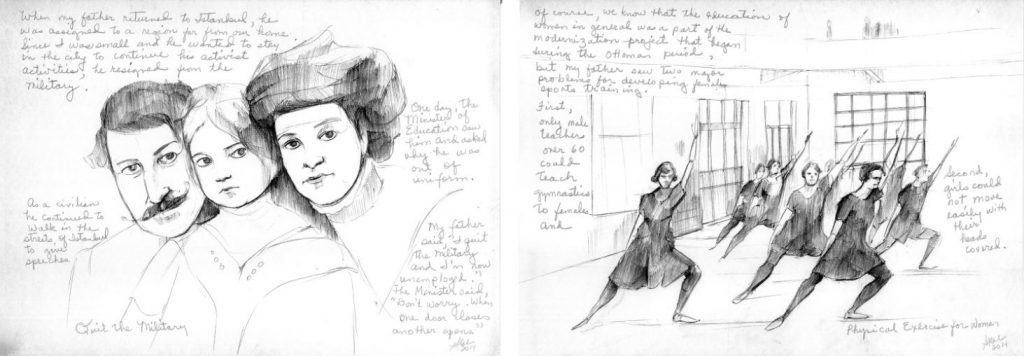
Nancy Atakan, “My Name is Azade (Freedom)”, Pencil Drawings with Handwritten Texts on Paper, 30×40 cm, 2014.
“During the transition from youth to maturity, external beauty and societal pressures may lessen, but shared memories and experiences assume importance.”
Your exhibition “It Is Still As It Always Was” at Pi Artworks London in 2020, is a joint project with Kalliopi Lemos including different disciplines and practices such as performance, video, artist book, sculpture, and embroidery. You are an American living in Istanbul, and Lemos is a Greek living in London. Therefore, migration, being a woman and cultural factors constitute the general themes of the exhibition. What did these two women show and tell us in this exhibition, can we listen from you?
Long-term colleagues and friends, Kalliopi Lemos and I began our collaborative research in the spring of 2018 and intensified our research in the autumn of 2018 after Yeşim Turanlı gave us a February 2020 exhibition date at Pi Artworks London. We traveled back and forth from London to Istanbul to Greece planning, searching for a film location, writing our scenario, and making objects to be used in our collaborative film “Necklace of Time”.
The genesis of “It Still Is as It Always Was”, Kalliopi Lemos and my first joint exhibition, comes from a common interest in women as the “keepers” of cherished stories, experiences, and memories that they pass down as a precious legacy through generations. During the transition from youth to maturity, external beauty and societal pressures may lessen, but shared memories and experiences assume importance.

Nancy Atakan and Kalliopi Lemos Collaboration, “Necklace of Time”, Double Channel Film, 8’14”, 2020.
“Necklace of Time” unfolds as a poetic and intense ritual that takes place in a mysterious environment. Wearing magnificent golden necklaces, reminiscent of Byzantine breastplates adorned with sumptuous colorful jewels referencing Ottoman designs, we engage in the task of removing the jewels from our beautiful necklace and replacing them one by one with delicately embroidered words that reflect our lived experiences and memories. While this video; individual work constructed using cloth and stitching; specifically crafted objects used in the film; and an opening night performance by us; intertwined in the same space to present our individual artistic practices and to reflect upon our similar yet different migration and assimilation lived experiences, the exhibition referenced the journey from youth to death shared by all women.
For the first time, “Necklace of Time” was shown in Turkey for a week on February 15-21, 2021 at Akbank Sanat in the video screening event entitled “Ubiquity”. During the lockdown, I have continued to work with cloth in my home studio. In 2020 and continuing into 2021, I have produced a large body of new needlework collage pieces.

Nancy Atakan, “Hand in Hand”, Needlework, Cloth, Lace, Felt, 120×157 cm, 2020.

Nancy Atakan, “Our Endless Debt to Plants”, Needlework, Crocheted Flowers, Paper, Felt, 85×98 cm, 2020.
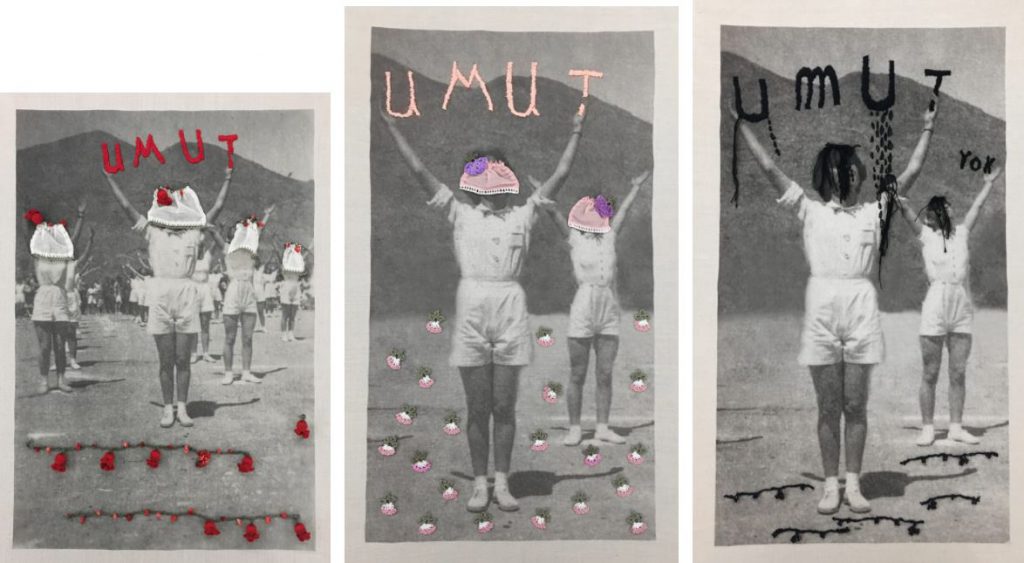
Nancy Atakan, “Between Hope and Hopelessness”, Digital Print on Textile, Needlework, 42×68 cm, 44×61 cm, 42×68 cm, 2018.
Our thanks are due to Nancy Atakan.
- For more information about the artist, you may visit her website.
- Besides the photos and visual images by Güncel Sanat Arşivi, all the other photos in this interview are used by courtesy of the artist from her website. Portrait Photograph by Rowan Durrant.
- The rights of all the visual and textual concepts in this interview are reserved. Quotation shall be allowed provided that the source shall be mentioned in the work where the quotation is cited. For the photos please contact the artist.
Please click for more information about Narratives Interview Series
